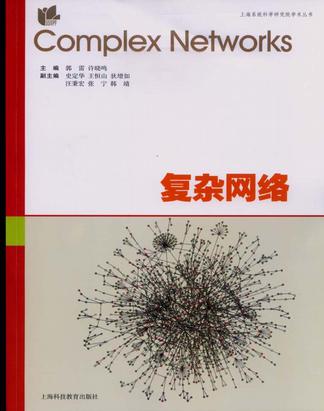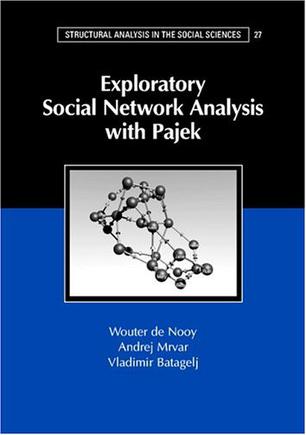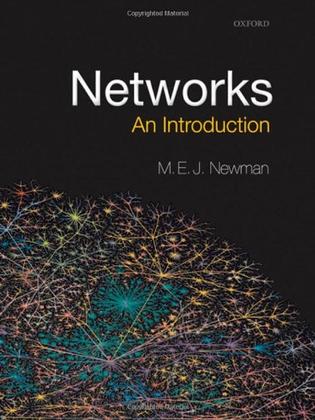-

请克林顿吃饭
《请克林顿共进晚餐》是你的第一本必读书,如果你希望在工作、生活的方方面面建立你的人际网络。在阅读这《请克林顿吃饭:成功者的人际网络》之前,请你先翻到第16页,完成“人际网络经营测试”,根据测试结果再进一步阅读《请克林顿吃饭:成功者的人际网络》。如果你希望了解“如何与他人建立联系”这一主题,请重点阅读第2章和第3章。如果“怎样树立自己的形象”是你关注的重点,第4章和第5章将会给你提供丰富的意见和建议。如果你更关心“在哪里和什么人建立联系”,第3章和第4章可以满足你在这方面的信息需求。如果你正在为“如何让重要人物注意到你”而烦恼,请翻到第4章认真揣摩。如果你想要达到经营人际网络的最高境界——合作,那么《请克林顿吃饭:成功者的人际网络》给你的建议可以在第6章中找到。如果你仅仅是对《请克林顿吃饭:成功者的人际网络》作者如何邀请到克林顿共进晚餐感兴趣,相信阅读《请克林顿吃饭:成功者的人际网络》能满足的不仅是你的这个好奇心,还有更多的求知欲。 -

复杂网络
-

Exploratory Social Network Analysis with Pajek
This is the first textbook on social network analysis integrating theory, applications, and professional software for performing network analysis (Pajek). Pajek software and datasets for all examples are freely available, so the reader can learn network analysis by doing it. In addition, each chapter offers case studies for practicing network analysis. The book will enable the reader to gain the knowledge, skills, and tools to apply social network analysis in all social sciences, ranging from anthropology and sociology to business administration and history. ======== Table of contents Part I. Fundamentals 1. Looking for social structure 2. Attributes and relations Part II. Cohesion 3. Cohesive subgroups 4. Sentiments and friendship 5. Affiliations Part III. Brokerage 6. Center and periphery 7. Brokers and bridges 8. Diffusion Part IV. Ranking 9. Prestige 10. Ranking 11. Genealogies and citations Part V. Roles 12. Blockmodels Appendix 1. Getting started with Pajek Appendix 2. Exporting visualizations Appendix 3. Shortcur Key Combinations -

Networks
The scientific study of networks, including computer networks, social networks, and biological networks, has received an enormous amount of interest in the last few years. The rise of the Internet and the wide availability of inexpensive computers have made it possible to gather and analyze network data on a large scale, and the development of a variety of new theoretical tools has allowed us to extract new knowledge from many different kinds of networks. The study of networks is broadly interdisciplinary and important developments have occurred in many fields, including mathematics, physics, computer and information sciences, biology, and the social sciences. This book brings together for the first time the most important breakthroughs in each of these fields and presents them in a coherent fashion, highlighting the strong interconnections between work in different areas. Subjects covered include the measurement and structure of networks in many branches of science, methods for analyzing network data, including methods developed in physics, statistics, and sociology, the fundamentals of graph theory, computer algorithms, and spectral methods, mathematical models of networks, including random graph models and generative models, and theories of dynamical processes taking place on networks. -

传播网络理论
《传播网络理论》2003年由牛津大学出版社出版,并获得20113年国际传播学会组织传播分会的年度最佳著作奖《传播网络理论》不仅抓住了传播中核心的网络问题,系统介绍了网络分析方法和工具,更为重要的是透过网络结构本身,深入分析了网络结构的生成机制问题,探讨了网络研究涉及的社会理论基础 书中提出了多理论多层次的网络研究框架,应用复杂适应系统观点分析传播网络并构建计算机仿真环境以验证各种理论与假设 书中还探讨了传播网络与其他网络的关系,为通过计算机仿真方法研究动态组织结构涌现提供了基础。 -

强大的弱连接
《强大的弱连接:中国Web2.0网络使用行为与网民社会资本关系研究》是作者朝着这一方向所做的努力。在《强大的弱连接:中国Web2.0网络使用行为与网民社会资本关系研究》中,作者首先全面深入地分析了三种主要的Web2.0网络应用(博客、社会网络书签和社交网站)的传播学意义。随后,以社会学中的“社会资本”概念为基础,通过实证研究考察了这三种网络使用行为对网民的社会资本(社会信任、社会网络以及社会参与)造成的影响。作者发现,Web2.0网民属于互联网社会化使用者、重度使用者、具有更多的“自愿”人际关系和更多的“弱连接”,并且更愿意进行“自我披露”等等,这些特征导致Web2.0使用者和非使用者之间在“社会资本拥有量”上形成差异一前者倾向于比后者拥有更多的社会资本一从而在两者间形成类似于“知沟”和“数码沟”的“社会资本沟”。作者相信,这种“社会资本沟”会在一定时期内持续存在,但最终会随着Web2.0技术和网站的主流化而逐渐缩小。最后,作者对关于Web2.0的一些争议从社会和文化角度做了分析,并通过案例探讨了Web2.0时代新闻业所面临的挑战和机遇。